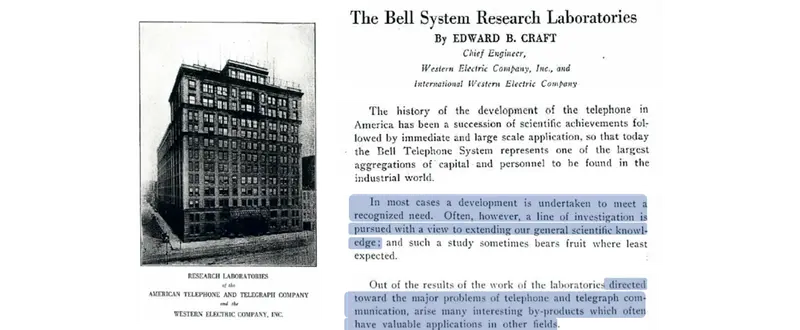2018 Nobel Prize in Physics

On the occasion of the fantastic announcement of the award of the 9th Nobel Prize to a Bell Labs researcher, Arthur Ashkin, for work undertaken at the Labs, I thought it would be a good time not only to acknowledge Arthur’s greatness but also to answer the two questions I am asked most frequently:
- How has Bell Labs achieved such ‘greatness’?
- Has Bell Labs changed – is it different now than in the past?
To answer both questions, one only has to look at one of the earliest documents written about Bell Labs, or the Bell System Research Laboratories, as it was known prior to its inauguration as Bell Telephone Laboratories in 1925. An excerpt from one of the earliest documents is shown below, with the key text highlighted, which can be summarized as follows:
- The Labs work is directed towards solving critical communications problems or ‘needs’
- In solving these problems, the extension of human scientific or technical knowledge is encouraged as unexpected benefits or ‘by-products’ will likely result

So simple, but so ‘right’ as an approach, as it combines the joint goals of real human problem solving (and the creation of associated products and services), with the pursuit of new human knowledge that will benefit humankind in myriad ways, not just in new understanding but also, most likely, in the additional creation of unforeseen new products and services that further enrich human existence.
Yet almost none of the former industrial research labs with apparently similar goals have had the longevity of Bell Labs, and I am often asked why this is. Is it just luck, or happenstance, or more than that? I am a staunch advocate of Richard Hamming’s position that the appearance of luck is an illusion created by conscientious activity, planning, and a willingness to adapt to new realities and find new opportunities. And I think this is the secret of Bell Labs success; the sequential parents of Bell Labs (Western Electric, AT&T, Lucent Technologies, Alcatel-Lucent and now Nokia) have seen the benefits of this constant adaptation and consequently have been advocates for the core modus operandi or credo of Bell Labs, described above.
But back to the story of our latest Nobel Laureate, Arthur Ashkin. In the 1970’s and 1980’s Bell Labs scientists, including Arthur Ashkin, were investigating the fundamentals of lasers, laser light propagation, and the interactions between laser light and materials, in order to advance our ability to develop novel long distance optical communications systems. The state of the art at the time included transmission using microwave relays or with hollow waveguide tubes carrying microwave signals, and conventional transmission over copper (twisted pair or coax), and these solutions were ultimately unsatisfactory for long distance communications. Arthur Ashkin was studying laser light interactions with matter and when he focused a laser beam on a tiny glass ball he found that, when positioned in a vacuum chamber, he could observe the radiation pressure that the laser light imparted to the glass sphere, which was able to counteract the forces of gravity and ‘levitate’. This observation led to the creation of the field of ‘optical trapping’, that led to the Bell Labs Nobel Prize for Steven Chu in 1997. However, the creation of ‘optical tweezers’ by Arthur to manipulate molecules and most importantly biological samples, has permitted the study of novel interactions and configurations which have allowed scientists to further unravel the mysteries of human life.
In short, Arthur was on a quest to improve human communications by understanding the limits of optical communications, and in the process, he created a technique that helped understand human life itself. Another classic Bell Labs tale, and one I anticipate will be repeated for decades to come, with the set of pioneering innovations we are currently working on that will define the 5G era and beyond. So, congratulations Arthur — you are the epitome of Bell Labs, past, present and future!
